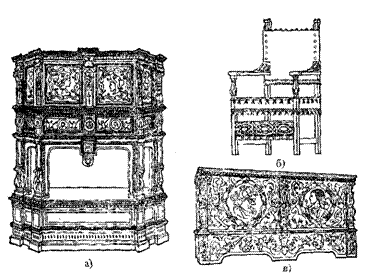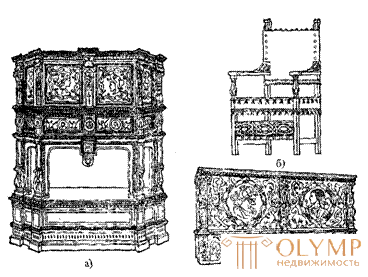
The artistic forms of the Renaissance began to spread in France at the end of the 15th century. and in the XVI century. reach its heyday. The French Renaissance is divided into four periods: the transition period (1498-1515); early Renaissance (1515-1547); Mature Renaissance (1547–1589); later Renaissance (1589-1646).
Already in the first periods of style development, new types of furniture appear. Thus, a dressuar appeared (Fig. 1, a) - a cupboard (set), developed from a chest raised on racks. Dressuar is dissected by pilasters Or columns into separate panels that are densely filled with relief carved ornamentation. Armchairs and chairs upholstered in fabric or leather, decorated with fringe and braid (Fig. 1, b) are distributed. The seats are found wicker seats and backs. Chests and lari (Fig. 1, c) are decorated with medallions with the image of heads.
A bed is a whole architectural structure, equipped with columns, a canopy, ornated with richly carved izloziem.
If in the Gothic style, the main material for the manufacture of furniture was oak, now his place was taken by a nut.
Characteristic decorative motifs in the furniture of the early French Renaissance were pilasters and cornices, panels with arabesques, heads in profile on long necks, enclosed in rich wreaths and flowing ribbons, turned columns in the form of balusters or candelabra with flame above, pilasters between panels and the emblem of the king in either as a beautifully intertwined monogram, or its emblem - a salamander in fire, decorated on top of a royal crown.
During the period of the mature Renaissance - the style of Henry II - magnificent Roman motifs prevail in the furniture.

Fig. 1. Furniture of the French Renaissance: a - dressuar (cupboard), the first half of the 16th century, b - a soft armchair, the end of the 16th century, and a chest decorated with carvings
Furniture is decorated with strong relief carvings, images of fantastic animals, porticos on cabinets, on the surface of the walls and on the doorposts make shallow niches framed and processed by architectural motifs in the ancient character. Gables, the final colonnades, make broken and between the side parts put the bust, statuette, vase or a small triumphal arch.
A characteristic furniture form of the late French Renaissance is a double cabinet (Fig. 2, a), in the solution of which architectural elements are widely used. The front side of the cabinet is built as an architectural structure, as the facade of a building: with columns and a pediment. The surface of the facade and drawers above the lower case are sometimes enriched with rectangular inserts of marble, on the panels there are shallow niches with statuettes or figures of ancient deities made with low relief. For sitting make a wooden chair with a high carved back (Fig. 2, b).
Parade tables, whose side panels retain openings, as in the Gothic era, but these openings give the form of an antique arch with powerful cannelized columns on the sides, take on an especially lush form. The thick timber connecting the side shields is lowered to the floor and forms a massive base, on which a number of turned balusters stand.

Fig. 2. Furniture of the late French Renaissance: a - double cabinet, b — armchair with hard wooden seat and carved back
Furniture in France first develops under the influence and with the participation of Italian masters. However, soon enough, their own masters appear, who unite in independent art schools.
Что бы оставить комментарий войдите
Комментарии (0)